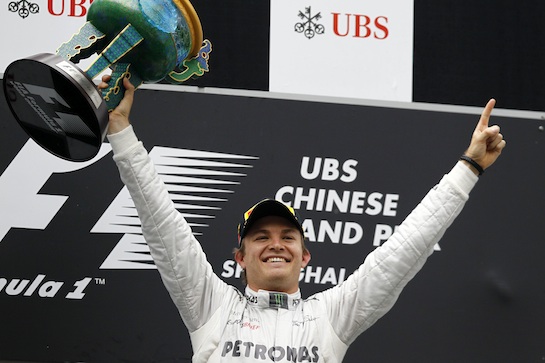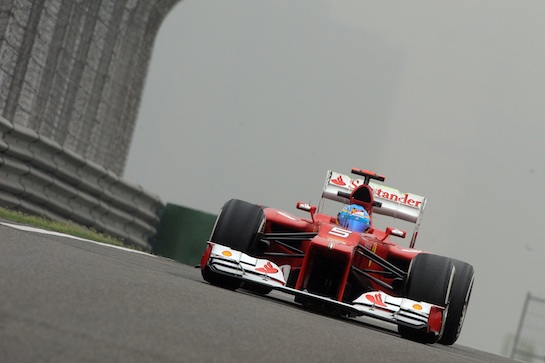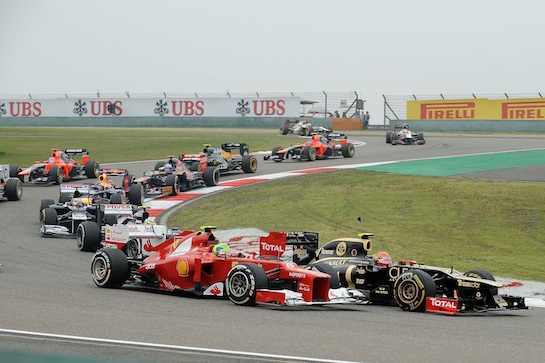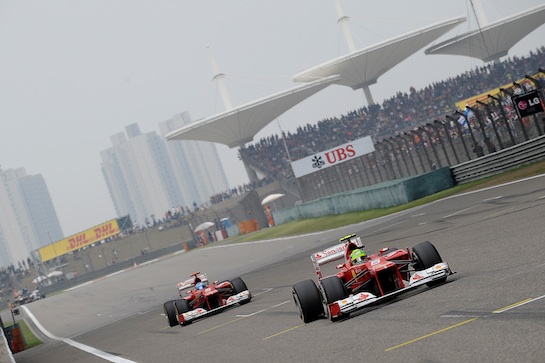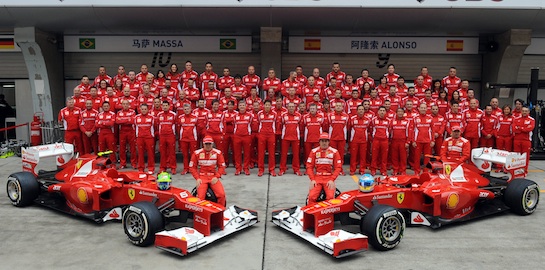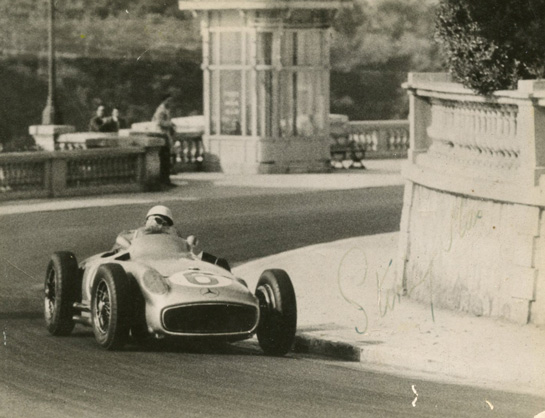
Stirling Moss at Monaco, 1955 with the Mercedes-Benz W196. With Fangio, the Mercedes team would win every Grand Prix that year aside from Monaco, where they retired with mechanical problems. Photo from author’s collection.
Chinese Grand Prix by Pete Vack
Photos courtesy and copyright Ferrari Media, unless otherwise noted
Mercedes-Benz won their first F1 race since 1955. That in itself is surprising, but the most significant aspect of their victory was the long struggle to achieve a true Mercedes-Benz win. The difficulties in succeeding in F1 today (already noted with great loss of dollars by Toyota, Jaguar, Honda, Porsche and others), demolished the tradition of German engineering supremacy, a shock and awe technique which once caused fear and loathing in its competitors.
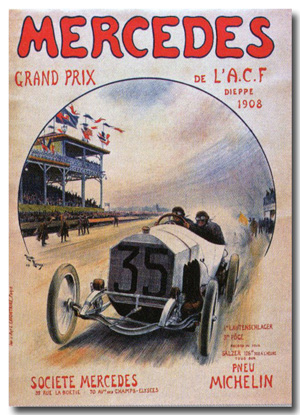
For the past 100 years, Mercedes, then as Mercedes-Benz, came onto the Grand Prix scene like a blitzkrieg, devastating all comers almost immediately with advanced designs, superb technology, a lot of money and the best drivers available. Then they would disappear for decades while the mere rumors of a comeback struck terror into the Grand Prix constructors both before and after WWII.
Mercedes first made a huge impact on Grand Prix racing when they won the prestigious 1908 French Grand Prix. It was all quiet on the western front until 1914, when three Mercedes team cars walked over the highly favored Peugeots on July 4th; the French were soundly defeated and equally furious. A month later the French and Germans would be at war. A devastating defeat for Germany was followed by years of economic woes. No serious Grand Prix car would emerge from what was now Mercedes-Benz for the next 20 years.
In February of 1934, to conform to a new 750KG Grand Prix formula, Mercedes-Benz introduced the W25, a breakthrough design with a 325 hp supercharged engine and a rear-mounted 4 speed transaxle. Mercedes would dominate Grand Prix racing with the W25, the W125 and the W154. The Italians decided to alter the formula for the 1939 Tripoli Grand Prix to the 1.5 liter rules, a class in which both Maserati and Alfa Romeo had competitive cars. Since the Germans had no such race cars, the Italians assumed that they would finally be able to break the German winning streak in Libya. However, Mercedes built two cars, largely in secret. The cars finished first and second. “..the W165 Mercedes-Benz scored one of the most stunning and memorable wins in the history of motor racing. Italian cars and drivers were humiliated,” wrote Karl Ludvigsen.
Another war and 15 years would pass with virtually no participation from Mercedes-Benz in Grand Prix racing. But for the new 2.5 liter Grand Prix Formula, in 1954, Mercedes introduced the W196 streamliner and open wheel cars for the 1954 and 1955 season. After a few teething problems they once again walked away with the laurels in both years. Shock and awe, to be sure

Ironically, it was yet another tragedy of enormous proportions that caused Mercedes to totally withdraw from racing for another thirty three years. The Le Mans disaster caused the board of Daimler-Benz to reconsider its participation in racing; they also knew that there was little else to prove, having won both the sports car and F1 championships in 1955.
There was to be no roar from Daimler-Benz until January 1988, when they announced a return to racing, participating in the Group C Endurance events with Sauber. It was successful, with 16 out of 18 wins, but it was not Grand Prix. In 1991 it was decided to drop out of the WSC events and concentrate on GT racing. But in the backroom the boys were playing Formula 1 behind the curtain.
Neither shock nor awe but struggle
The WSC era was followed by a complex arrangement to assist with the creation of the Mercedes Ilmor motor and the Sauber chassis but resulted in no concrete successes. By 1995, an agreement with McLaren provided the Mercedes Ilmotor engine to Ron Dennis’ team. A breakthrough came in 1997, as David Coulthard won the Australian Grand Prix. This then was Mercedes’ first F1 success since Monza in 1955, but it was only a half win; the chassis was McLaren and even the Ilmor motor was engineered by Swiss Mario Illien and Brit Peter Morgan (the Ill and Mor of the name). In 1998, the McLaren-Mercedes won championships with Mika Häkkinen driving and in 1999 he did it again. Hamilton would take the McLaren-Mercedes to another world championship in 2008 and Button would manage another with the Brawn-Mercedes in 2009.
But the Anglo-German effort, as successful as it was, was not pure Mercedes. That would be remedied in 2010 when the full might of Mercedes-Benz got behind F1 and Ross Brawn along with that other guy they lost to Ferrari. Of course it is hard to tell where the 2009 Brawn ends and Mercedes begins. But since then it would not be shock nor awe but a difficult struggle to maintain position in mid pack. Mercedes was back in full, but no one was shaking in their Guccis.
The Race
The Chinese Grand Prix was an epic event in its own right. It was truly great seeing Rosberg and Schumacher one-two on the front row. Amazed at what appeared to be Schumacher’s giving way to Rosberg (orders?) we were saddened when he retired due to a loose wheel nut on Lap 13. It was even nice seeing a more or less proper Mercedes-Benz winning a Grand Prix once more. Rosberg did a superb job throughout the race, a well deserved victory. But it was his 101th Formula 1 race and only his first victory. Something here does not equate, but it may be part of the mysteries of F1 today. Y’just never know.
Perez (who led the race briefly on Lap 14) and Kobayachi were on right up front with the Sauber Ferraris. Sixty years ago these guys would never have made it this far…they are fearless and tough but would have been caught out by a tree, a bridge, or a lamppost.
Of course we’ve been harping for two years that Kobayachi should be given a good ride…lacking that at least the Sauber team has come up with a good ride themselves, moving from the back of the grid to the front, no doubt thanks in large part to their two tiger drivers. Could Sauber be the next Red Bull?
Everyone had written off Vettel and yet he worked his way up from 14th to second at one point, until caught in the high strung sprint race near the end. Still, he did well and still finished 5th. No one should write off Vettel yet for this year, it’s far too early.
The track at Shanghai appears to be as boring as the current crop of constipated circuits can be, but it nevertheless provided the most stirring driving and racing we have seen this year, perhaps in several years. With six World Champions on the track and cars that are as evenly matched as ever, the racing is awesome. Positions 2-8 changed so fast in the latter part of the race that it was impossible to keep up, even though everyone had their last tire change. We looked in vain for update positions on the screen and they too, seemed unable to cope with the place changes. By lap 48 Vettel was in second, with Rosberg still holding the lead. But the race between Button, who finished second, and Hamilton, 3rd and Weber who placed 4th was amazing. The fearless foursome pushed the aggressive Perez and Kobayashi down to midfield positions and left no doubt as to who was a World Champion and who was not.
So will Mercedes now continue on a winning streak as dictated by their tradition? Maybe, but that’s the fun of F1. Y’just never know.
BTW: Time and time again we have referenced all four of the books in the “Racing Color” series edited by Karl Ludvigsen. They are handy, very accurate, and allow us quick insights into what the Germans, French, British and Italians were doing in any given era. “German Racing Silver”, also written by Ludvigsen, was published by Ian Allan Publishing in 2009 and was a great help in writing this article. The poster and cutaway above also appear in the book.
Race Results
| 1 | ROSBERG | Mercedes | 1h36m26.929s |
| 2 | BUTTON | McLaren-Mercedes | + 20.6s |
| 3 | HAMILTON | McLaren-Mercedes | + 26.0s |
| 4 | WEBBER | RBR-Renault | + 27.9s |
| 5 | VETTEL | RBR-Renault | + 30.4s |
| 6 | GROSJEAN | Lotus-Renault | + 31.4s |
| 7 | SENNA | Williams-Renault | + 34.5s |
| 8 | MALDONADO | Williams-Renault | + 35.6s |
| 9 | ALONSO | Ferrari | + 37.2s |
| 10 | KOBAYASHI | Sauber-Ferrari | + 38.7s |
| 11 | PEREZ | Sauber-Ferrari | + 41.0s |
| 12 | DI RESTA | Force India-Mercedes | + 42.2s |
| 13 | MASSA | Ferrari | + 42.7s |
| 14 | Räikkönen | Lotus-Renault | + 50.5s |
| 15 | HULKENBERG | Force India-Mercedes | + 51.2s |
| 16 | VERGNE | STR-Ferrari | + 51.7s |
| 17 | RICCIARDO | STR-Ferrari | + 63.1s |
| 18 | PETROV | Caterham-Renault | + 1 lap |
| 19 | GLOCK | Marussia-Cosworth | + 1 lap |
| 20 | PIC | Marussia-Cosworth | + 1 lap |
| 21 | DE LA ROSA | HRT-Cosworth | + 1 lap |
| 22 | KARTHIKEYAN | HRT-Cosworth | + 2 laps |
| 23 | KOVALAINEN | Caterham-Renault | + 3 laps |
| 24 | SCHUMACHER | Mercedes | + 44 laps, wheel |
| Fastest Lap |
KOBAYASHI | Sauber-Ferrari | 1m39.960s |
Note – Hamilton qualified second, but dropped five grid places as penalty for an unscheduled gearbox change. Vergne qualified 18th, but started from pit line following pre-race car changes.
Driver’s Championship Standings
| 1 | HAMILTON | McLaren-Mercedes | 45 Points |
| 2 | BUTTON | McLaren-Mercedes | 43 Points |
| 3 | ALONSO | Ferrari | 37 Points |
| 4 | WEBBER | RBR-Renault | 36 Points |
| 5 | VETTEL | RBR-Renault | 28 Points |
| 6 | ROSBERG | Mercedes | 25 Points |
| 7 | PEREZ | Sauber-Ferrari | 22 Points |
| 8 | Räikkönen | Lotus-Renault | 16 Points |
| 9 | SENNA | Williams-Renault | 14 Points |
| 10 | KOBAYASHI | Sauber-Ferrari | 9 Points |
| 11 | GROSJEAN | Lotus-Renault | 8 Points |
| 12 | DI RESTA | Force India-Mercedes | 7 Points |
| 13 | VERGNE | STR-Ferrari | 4 Points |
| 14 | MALDONADO | Williams-Renault | 4 Points |
| 15 | RICCIARDO | STR-Ferrari | 2 Points |
| 16 | HULKENBERG | Force India-Mercedes | 2 Points |
| 17 | SCHUMACHER | Mercedes | 1 Point |
Constructor’s Championship Standings
| 1 | McLAREN-MERCEDES | 88 Points |
| 2 | RBR-RENAULT | 64 Points |
| 3 | FERRARI | 37 Points |
| 4 | SAUBER-FERRARI | 31 Points |
| 5 | MERCEDES | 26 Points |
| 6 | LOTUS-RENAULT | 24 Points |
| 7 | WILLIAMS-RENAULT | 18 Points |
| 8 | FORCE INDIA-MERCEDES | 9 Points |
| 9 | STR-FERRARI | 6 Points |
